Ravensburg was first mentioned in a document in 1088. The core of today's city was built as a settlement below the mighty ancestral castle of the Guelphs on the hill between Flappach- and Schussental.
From the Ravensburg the Guelphs administered their ancestral lands in Swabia. Welf IV. was appointed Duke of Bavaria in 1070; his grandson Heinrich the Proud was able to obtain the title of Duke of Saxony in 1137 by marriage to Gertrud von Supplinburg. In contrast, the Swabian dukedom always remained reserved for their fiercest political rivals, the Staufer.
The few remaining Representations show the castle as a representative and at the same time well-fortified ducal castle, which, however, used half of the plateau, which was secured with its steep slopes on three sides, while the front half was used as a tournament place.
In 1129 the famous son of Henry the Proud and Gertrud von Supplinburg, Henry the Lion, was born, probably on the Ravensburg. After the death of Henry the Proud in 1139, the leadership of the House of Guelphs and the rule of Ravensburg fell to his brother Welf VI, Duke of Spoleto. At first he defended the Guelph interests with great success, but after the death of his son Welf VII in 1167 he lost interest in politics and finally bequeathed the Ravensburg in 1178 to his nephew, the Emperor Frederick I Barbarossa of the Hohenstaufen dynasty. He thus disappointed his other nephew, Henry the Lion, Duke of Bavaria and Saxony. From then on Ravensburg belonged to the Staufer family.
In 1278, the Habsburg Emperor Rudolf I confirmed the imperial privileges of the town of Ravensburg below the castle. From then on the imperial bailiff of the imperial bailiwick of Swabia sat at the castle itself. Over time, to avoid confusion, the castle was no longer called Ravensburg, but was instead called Veitsburg (after the castle chapel consecrated to Sankt Veit - St. Vitus) near Ravensburg.
During the Thirty Years War the castle was almost completely razed to the ground by Swedish troops. The seat of the bailiff was then moved to Weingarten. In the 18th century, the town magistrate was able to purchase the castle hill from the Empire. He had a small baroque castle built on the ruins by Johann Caspar Bagnato.
Today a restaurant is located in Bagnato's building and modern annexes. Outbuildings of the castle complex - once used as a farm and stable - serve as a youth hostel.
The town has preserved its medieval character with remains of the town wall and town towers and some Gothic buildings.
Green tower with city wall and Frauentor
View through Marktstrasse from Obertor to Blaserturm.
Tower (Untertor) and parking garage
Blaserturm and Waaghaus
The Jodok church has retained its original 14th century character.
St. Jodok with his pilgrim costume and staff resembles a little bit James. He is represented with the crown at his feet, which he has renounced.
The Blaser Tower
View from the Blaserturm


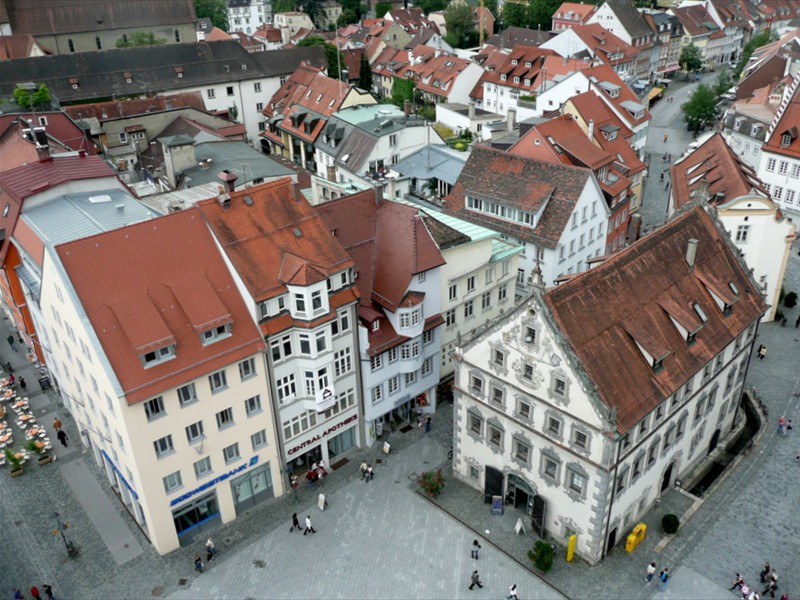
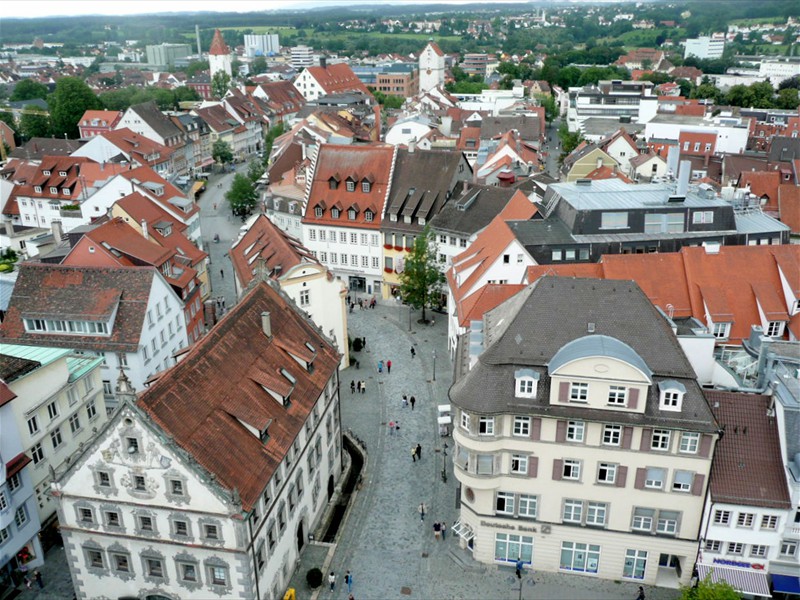 From there the Jakobsweg continues in the direction of Constance in the Meersburger Strasse
From there the Jakobsweg continues in the direction of Constance in the Meersburger Strasse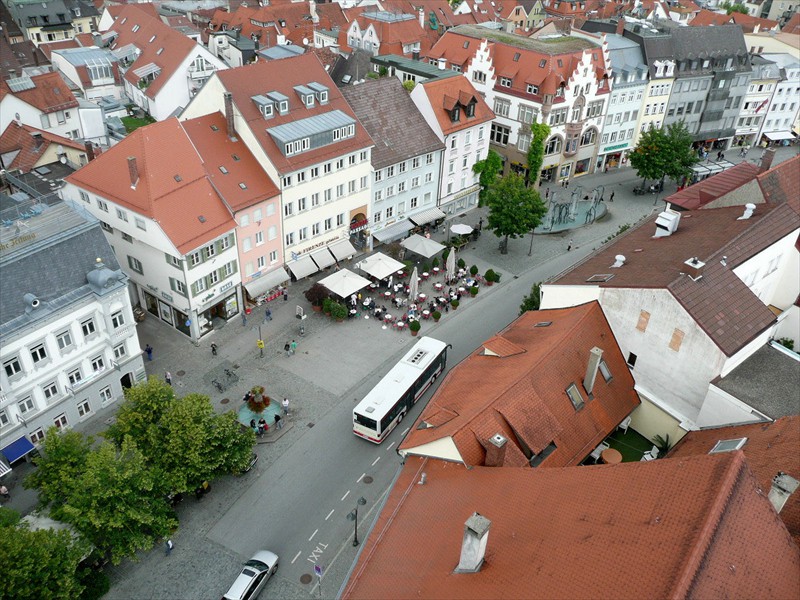


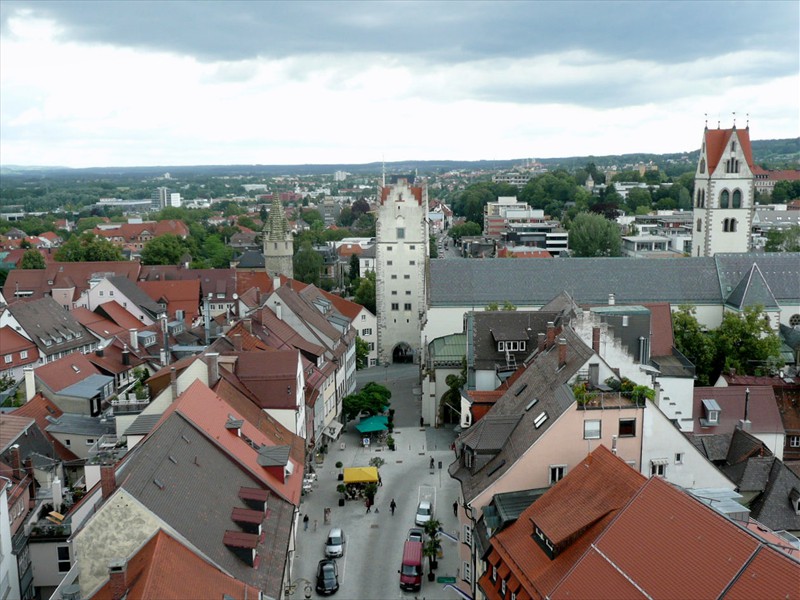
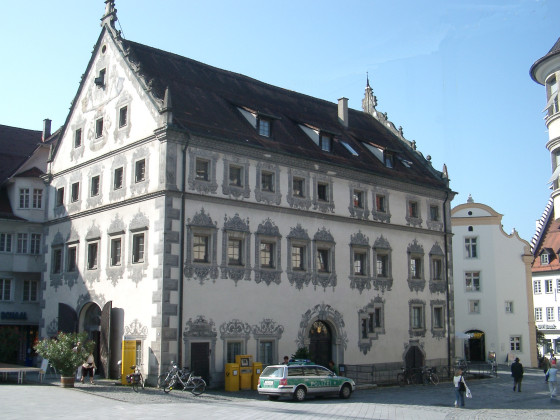
The Lederhaus on Marienplatz was built around 1400 as a central sales outlet for shoemakers, saddlers and tanners and was considerably enlarged in 1512/1513.
The town hall was built in 1386. On the north side you can see the court oriel from 1571 and inside there are two late gothic council halls.
The Marienplatz
Liebfrauenkirche
The Liebfrauenkirche (church) was built in the 14th century in gothic style.
The interior of the Liebfrauenkirche
The sculpture of the Madonna with the protective mantle was probably created by Friedrich Schramm or Michel Erhart around 1480 in Ravensburg. It consists of lime wood and is 135 cm high.

The original of the sculpture is in the National Museums in Berlin, Sculpture Collection and Museum of Byzantine Art (Bodemuseum, Berlin-Mitte), in the Liebfrauenkirche there is a copy from 1935.
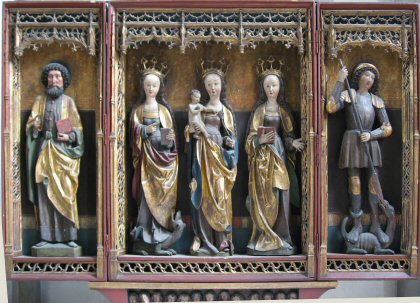
High altar from 1519 (bought from Switzerland).
West portal of the Liebfrauenkirche with tympanum with scenes from the life of Mary
By bike on the Way of St. James Leipzig - Constance

Weingarten |
Way of St. James Ulm - Constance |

further |

In search of Gertrud
After her marriage to Henry the Proud (Heinrich der Stolze), Gertrud von Supplinburg came to Ravensburg in 1127 to the ancestral castle of the Guelphs. She was 12 years old at that time! At the age of 14 she gave birth to her son "Henry the Lion (Heinrich der Löwe)".

She's not buried here!